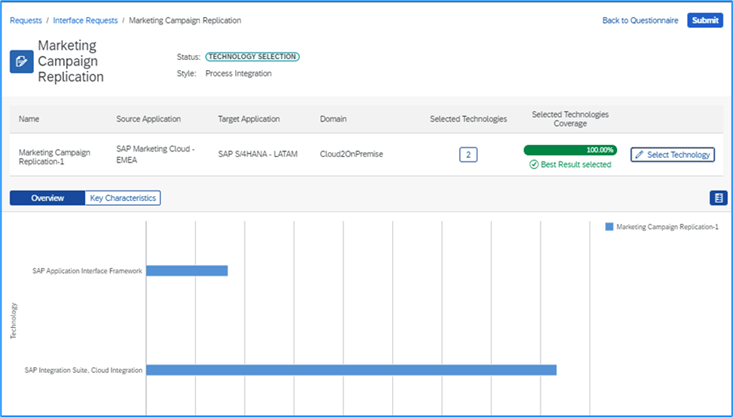
2023-11-6 23:27:5 Author: blogs.sap.com(查看原文) 阅读量:7 收藏
In dynamic and constant changing times enterprises need to become more agile and resilient. But for many, fragmented process landscapes prevent them from reacting quickly to change.
According to the results of an ESG study from 2022, 83% of organizations say improving enterprise integration is a top-5 business priority for the next 12-24 months and 96% say that the need for enterprise integration was identified by the office of the CIO. However, only 27% report that they have a mature enterprise integration practice in place. Apparently, most organizations struggle with defining and executing an enterprise integration strategy. This is where the SAP Integration Solution Advisory Methodology can help.
The SAP Integration Solution Advisory Methodology allows you to increase the integration maturity level in your organization. It offers an adaptable framework that includes integration use case patterns, reference architectures, and additional best practices for cloud and hybrid IT landscapes (see figure below). 
SAP Integration Solution Advisory Methodology
Its scope isn’t limited to technical aspects, but also covers the organizational dimension of enterprise integration like setting up an Integration Center. A well-defined adoption path allows you to apply the methodology step by step. Furthermore, it is an open framework whose concepts you can apply to integration technologies from SAP or to the ones from other vendors.
The phases of the methodology
The SAP Integration Solution Advisory Methodology is structured into four phases which can be further be subdivided into steps. In the following we will take a quick look at the scope of each phase.
1. Assess your integration strategy
As a starting point an enterprise architect uses the SAP Integration Solution Advisory Methodology to identify the future building blocks for an organization’s integration architecture. For this purpose, the methodology offers a technology-agnostic scoping approach along integration domains, integration styles and integration use case patterns (see figure below).

Integration styles and integration use case patterns
As a result, you will have defined the functional scope of an organization’s future hybrid integration platform.
2. Design your hybrid integration platform
In this phase, an enterprise architect maps the results of the integration strategy assessment to the matching integration technologies based on customer context factors. In this context SAP Integration Suite plays a crucial role as it supports a broad scope of integration use case patterns and is open to integrate with both, solutions from SAP and third-parties (see figure below).

SAP Integration Suite
For each integration technology an integration architect specifies integration policies that describe when to use which technology. Whenever integration developers plan to implement an integration scenario, they can perform an interface assessment to determine the best fitting integration technology with the help of the concepts of this methodology.
3. Define integration best practices
Next, an integration architect defines architecture blueprints for the integration use case patterns that are relevant for their organization. For this purpose, you can use the SAP BTP reference architectures of SAP Discovery Center. These also include architectures for the integration use case patterns of the SAP Integration Solution Advisory Methodology (see screenshot below).

Reference architectures at SAP Discovery Center
Furthermore, the integration architect can define integration dos and don’ts, which integration developers can use as guardrails to implement integration scenarios in a consistent fashion. The integration architect also prepares development guidelines for applicable integration technologies, for instance by enriching vendor-specific best practices with customer-specific aspects such as naming conventions for integration artifacts.
4. Enable a practice of empowerment
The last phase focuses on non-technical but organizational aspects of enterprise integration. These include concepts for institutionalizing an Integration Center of Excellence, which allows decentralized project teams to develop integration scenarios in an agile way based on the defined integration strategy. This phase also covers best practices for integration governance and integration quality assurance across an organization.
Thereof the Integration Assessment capability within SAP Integration Suite is the best means for introducing integration governance (see screenshot below).

Technology proposal from Integration Assessment
Integration Assessment automates key parts of the SAP Integration Solution Advisory Methodology and can help you to modernize your integration approach by leveraging the latest integration technology recommendations from SAP.
Part of the new SAP BTP Guidance Framework
The SAP Integration Solution Advisory Methodology is an integral part of the SAP BTP Guidance Framework (see figure below) which has been released at SAP TechEd 2023.

SAP BTP Guidance Framework
The SAP BTP Guidance Framework provides a central access point for architects, developers and administrators to build and run enterprise-grade solutions on BTP. It acts as a compass toward architecting, developing, and operating BTP based solutions. With regards to integration the framework offers for instance an integration architecture guide, SAP Integration Solution Advisory Methodology, and reference architectures.
Your next steps
If you are looking for more details about the SAP Integration Solution Advisory Methodology you may check out the following resources:
Start with an overview
- Whitepaper: SAP Integration Strategy
- Web page: SAP Integration Solution Advisory Methodology
- Video: Integration Assessment capability within SAP Integration Suite
Explore the details
- Blog post: Integration Assessment capability within SAP Integration Suite is general available now
- Video: Enterprise Integration Strategy with SAP Integration Solution Advisory Methodology
- Guide: Integration Architecture Guide for Cloud and Hybrid Environments based on SAP Integration Solution Advisory Methodology
Learn more and get started
- SAP Discovery Center Mission: Get started with the Integration Assessment capability within SAP Integration Suite
- Documentation: SAP Integration Solution Advisory Methodology, including free templates for download
- Documentation: Integration Assessment capability within SAP Integration Suite
如有侵权请联系:admin#unsafe.sh